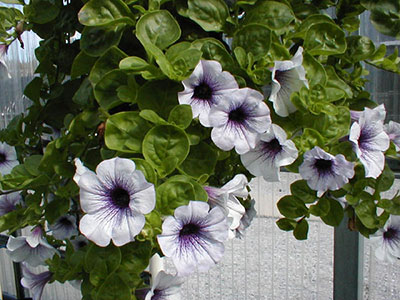Petunias

In Florida, petunias are a popular winter annual. Their long flowering period, the wide array of colors and forms available, and the ease with which they grow make them a favorite among gardeners.
Characteristics
Petunias (Petunia spp.) were originally native to South America, but the petunias that we grow today (Petunia x atkinsiana) comprise a large family of hybrids derived from many species. Petunias are usually separated into two categories; grandiflora (large-flowered) and multiflora (many-flowered).
With so many varieties to choose from, the form of each petunia plant will vary greatly. Some petunias will only grow to be about 6 inches tall while others can get over a foot tall. The spread of your petunia plant will depend on the variety as well, with some varieties spreading only about 18 inches while others can spread out as much as 4 feet.
Petunia flowers are also incredibly variable in terms of size, shape, hue, and color pattern; some petunias even have sweet fragrances. While some varieties have small flowers, only about an inch in diameter, others have flowers as large as 6 inches across. Flowers can be ruffled, fringed, or double, in almost any color imaginable. Some flowers will be one solid color while others have contrasting veins or edges, and in some varieties the flower even has a star pattern.
This variety of petunias makes them quite versatile in the landscape. They can be used for color masses, in containers, hanging baskets, or as a seasonal groundcover.
Planting and Care
In Florida, October and November are the best time to plant petunias. Petunias will grow best in full sun and well-drained soil that is kept moist. If you’re planting petunias as a groundcover, be sure to space plants 12 to 18 inches apart. Petunias should be given at least 1 to 2 inches of water every 7 to 10 days once established. Light, frequent waterings should be avoided as it will encourage shallow rooting. Fertilize your petunias monthly with a balanced fertilizer or use a controlled-release product such as Osmocote or Dynamite at the time of planting.
You can pinch off the top inch of petunia plants to encourage good branching. Deadheading is necessary on large-flowered and double petunias while many of the smaller flowered cultivars are self-cleaning. Gardeners in North Florida may have to protect their petunias from frost.
Petunias have few serious insect or disease pests. Aphids and caterpillars may be an occasional problem. Petal blight can be a problem in rainy and very humid weather; avoid getting leaves or flowers wet when watering. Viruses occasionally affect petunias. Modern petunias have been hybridized with disease-resistant old fashioned types to resist botrytis rot. These hybrids are also more tolerant of temperature extremes and produce more flowers. The ‘Wave’ hybrids were created to tolerate warmer temperatures.
With just a little bit of work petunias can provide you with cool season color and cheer in your landscape. For more information on growing petunias in your area contact your county Extension office.
